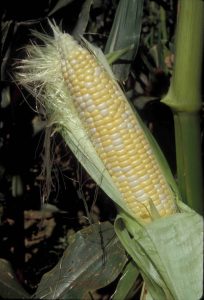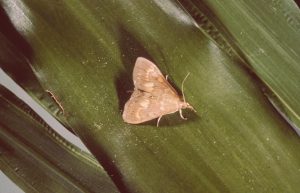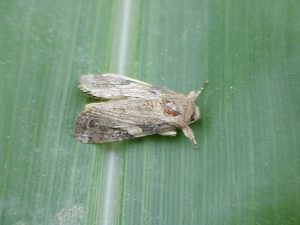Sweet Corn IPM Newsletter No. 2 – July 6, 2018
 Sweet Corn IPM Newsletter No. 2 – July 6, 2018
Sweet Corn IPM Newsletter No. 2 – July 6, 2018
Click on photos to enlarge.
CORN EARWORM THREATENS EARLY SILKING CORN
European Corn Borer Damage on the Rise
SITUATION
A string of very hot, humid days has pushed corn development along rapidly, especially in irrigated fields. Hail ripped up young corn in a few fields, but young corn is likely to recover from the damage. Transplanted corn and some seeded under plastic mulch is silking in southern Maine, indicating that the start of harvest could be only two to three weeks away. The hot weather has also stimulated more insect activity, as we have found a couple of fields over threshold for European corn borer damage, and a couple of early corn earworm moths in traps along the coast.

European corn borer: Moths were caught in pheromone traps in southern and coastal sites this week, and larval feeding damage is showing up on whorl to tassel stage corn. In whorl stage corn the control threshold is 30% of plants showing feeding injury. Once the plants reach the pre-tassel stage the threshold is lowered to 15%, because larvae at this stage are more likely to damage the ears. Pre-tassel fields in Biddeford, Bowdoinham and Dayton were over control threshold for pre-tassel corn, so sprays were recommended. Sprays during the pre-tassel stage, when both moths and larvae are present, target the larvae before can they move into the protection of the stalks and ears. Once corn reaches the silk stage, sprays may be based on the number of corn borer moths caught in pheromone traps rather than feeding injury. If more than 5 moths are caught in pheromone traps in a week near silking corn, a spray is recommended to prevent moths from laying eggs on the flag leaves of the ears, which could lead to larvae infesting the ears while leaving no visible signs of feeding on the leaves. So far, none of the silking fields have been over the 5-moth threshold.
Corn earworm: Moths were caught in pheromone traps at two coastal locations, Cape Elizabeth and Nobleboro. Both of these captures were single moths, which does not trigger a spray, even if silking corn is present. Once more than one moth per week is captured in a silking field, a spray interval would be recommended, based on the number of moths being caught. The more moths caught, the more frequently the silking corn will need to be sprayed to adequately protect it. (See table below.) At present, there is very little silking corn available for earworm moths to lay eggs on, so the threat is low for most fields. When no silking corn is available, corn earworm moths may lay eggs on corn leaves, and the larvae will chew large, ragged holes in the leaves, similar to fall armyworm.
- Corn Earworm Moth; photo by David Handley
- Male Fall Armyworm Moth; photo by David Handley
Fall armyworm: No moths have been captured in our pheromone traps this week, and no feeding damage has been reported. Although this is usually the last major corn pest to arrive in Maine from southern overwintering sites, it often follows corn earworm closely, and was the most significant pest problem in most corn fields for the past two seasons.
Common armyworm is often found chewing on early corn. Like fall armyworm, this caterpillar chews large holes in whorl to pre-tassel corn. The larvae are light brown with yellow and black stripes running along the body. This insect overwinters in Maine and is usually only present early in the season. Young corn can often outgrow the injury. However, heavy infestations can occur and may require control. We have found some common armyworm in western Maine this week, but not at significant levels.
Sincerely,
David T. Handley
Vegetable and Small Fruit Specialist
Highmoor Farm, P.O. Box 179, 52 US Route 202, Monmouth, ME 04259, 207.933.2100
UMaine Extension Diagnostic Research Lab, Pest Management Unit, 17 Godfrey Drive, Orono, ME 04473, 1.800.287.0279
| Location | CEW Moths |
ECB Moths |
FAW Moths |
%Feeding Damage |
Recommendations / Comments |
|---|---|---|---|---|---|
| Biddeford | 0 | 1 | 0 | 23% | One spray for ECB on pre-tassel corn |
| Bowdoinham | 0 | 0 | 0 | 15% | One spray for ECB on pre-tassel corn |
| Cape Elizabeth I | 0 | 3 | 0 | 4% | No spray recommended |
| Cape Elizabeth II | 1 | 4 | 0 | 4% | No spray recommended (corn not yet silking) |
| Dayton I | Set up | Set up | Set up | 16% | One spray for ECB on pre-tassel to silking corn |
| Farmington | 0 | 0 | 0 | 0% | No spray recommended |
| Lewiston I | 0 | 0 | 0 | 4% | No spray recommended |
| Lewiston II | Set up | Set up | Set up | 0% | No spray recommended |
| New Gloucester | 0 | 0 | 0 | 0% | No spray recommended |
| Nobleboro | 1 | 2 | 0 | 13% | No spray recommended |
| No. Berwick | Set up | Set up | Set up | 14% | No spray recommended |
| Oxford | 0 | 0 | 0 | 15% | One spray for ECB on pre-tassel corn |
| Wayne | 0 | 0 | 0 | 0% | No spray recommended |
| Wells I | Set up | Set up | Set up | 0% | No spray recommended |
| Wells II | Set up | Set up | Set up | 0% | No spray recommended |
CEW: Corn earworm (Only fresh silking corn should be sprayed for this insect.)
ECB: European corn borer
FAW: Fall armyworm
| Moths caught per week | Moths caught per night | Spray interval |
|---|---|---|
| 0.0 to 1.4 | 0.0 to 0.2 | No spray |
| 1.5 to 3.5 | 0.3 to 0.5 | Spray every 6 days |
| 3.6 to 7.0 | 0.6 to 1.0 | Spray every 5 days |
| 7.1 to 91 | 1.1 to 13.0 | Spray every 4 days |
| More than 91 | More than 13 | Spray every 3 days |
Thresholds apply only to corn with exposed fresh silk. Lengthen spray intervals by one day if maximum daily temperature is less than 80°F.
European Corn Borer Thresholds
Whorl stage: 30% or more of plants scouted show injury.
Pre-tassel-silk: 15% or more of plants scouted show injury.
Silk: 5 or more moths caught in pheromone traps in one week.
IPM Web Pages:
UMaine Cooperative Extension Integrated Pest Management
Penn State Pest Watch for Sweet Corn
UMass Amherst Integrated Pest Management
Where brand names or company names are used, it is for the reader’s information. No endorsement is implied nor is any discrimination intended against other products with similar ingredients. Always consult product labels for rates, application instructions and safety precautions. Users of these products assume all associated risks.
The University of Maine is an equal opportunity/affirmative action institution.


